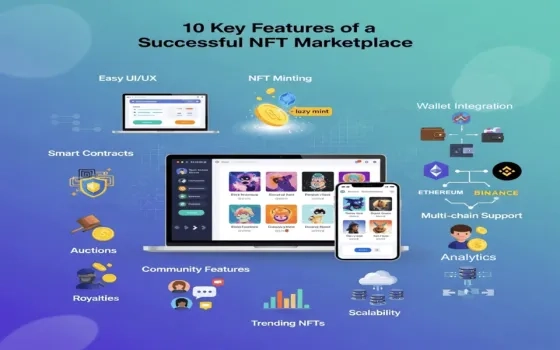The cryptocurrency ecosystem continues to evolve rapidly, and stablecoins have become one of the most critical innovations in digital finance. Unlike volatile cryptocurrencies, stablecoins are pegged to assets like fiat currency, commodities, or algorithms, ensuring consistent value for users. This stability has made them a preferred choice for payments, remittances, DeFi applications, and cross-border transactions. For businesses, launching a custom stablecoin in 2025 opens up new opportunities to build trust, enhance liquidity, and tap into the growing demand for digital financial solutions.
However, creating a stablecoin isn’t as simple as launching a token. It requires careful planning, a strong technical foundation, compliance with regulations, and a clear understanding of the different stablecoin models. Whether you are a fintech startup, an enterprise, or a blockchain entrepreneur, a step-by-step approach is essential for success. This guide will walk you through everything you need to know from ideation and technology selection to tokenomics, compliance, smart contract development, and market launch helping you transform your vision into a fully functional and trusted stablecoin in 2025.
Understanding Custom Stablecoin Development
Custom stablecoin development is the process of creating a stable cryptocurrency tailored to specific business or ecosystem needs. Unlike regular cryptocurrencies, stablecoins are designed to maintain a consistent value by being pegged to assets such as fiat currencies, commodities, or crypto reserves. This stability allows businesses to integrate them into payment systems, cross-border transactions, and decentralized finance (DeFi) applications without worrying about market volatility. Developing a custom stablecoin gives organizations control over its structure, governance, and features, ensuring it aligns with their financial strategies and user demands.
In 2025, the demand for custom stablecoins is rapidly growing as businesses, financial institutions, and even governments recognize their role in bridging traditional finance with blockchain technology. A tailored stablecoin can enhance liquidity, reduce transaction costs, and establish trust in digital ecosystems. Moreover, integrating compliance frameworks, advanced smart contracts, and user-friendly interfaces ensures security and scalability. By customizing a stablecoin, companies can position themselves at the forefront of financial innovation, creating digital assets that not only drive adoption but also reshape how value is exchanged globally.
Why Build a Custom Stablecoin in 2025?
Stablecoins are becoming a cornerstone of the digital economy, bridging the gap between traditional finance and blockchain ecosystems. In 2025, businesses and developers are exploring custom stablecoin creation to gain competitive advantages and address market needs. Here are the key reasons why building one can be highly beneficial:
1. Enhanced Financial Stability
A custom stablecoin provides stability in volatile markets by pegging its value to fiat, commodities, or crypto assets. This ensures predictable pricing for transactions, making it an attractive option for both businesses and users. In turn, it fosters trust, encourages adoption, and supports long-term growth within blockchain ecosystems.
2. Improved Liquidity Management
Stablecoins act as a reliable medium of exchange and store of value, which helps businesses manage liquidity more efficiently. By developing a custom stablecoin, organizations can create a seamless flow of capital across exchanges, DeFi platforms, and payment systems, boosting operational efficiency and accessibility.
3. Lower Transaction Costs
With blockchain-powered transactions, stablecoins significantly reduce intermediaries, cutting down on fees associated with cross-border payments. A custom stablecoin allows companies to design tailored transaction models that align with their business needs while delivering cost-effective solutions to end users.
4. Stronger Regulatory Control
Custom stablecoins enable businesses to integrate compliance frameworks like KYC/AML and adhere to jurisdictional laws. This approach not only enhances credibility but also minimizes legal risks. With governments tightening regulations in 2025, having control over compliance gives organizations a clear advantage.
5. Competitive Edge in Web3
Developing a custom stablecoin positions businesses as innovators in the Web3 space. It helps them tap into DeFi, NFTs, gaming, and metaverse ecosystems with a reliable currency that drives user engagement. This strategic move strengthens brand visibility and ensures long-term relevance in the evolving digital economy.
Step 1: Define Your Stablecoin Model
The first step in building a custom stablecoin in 2025 is choosing the right model that aligns with your business goals and target audience. Stablecoins can be designed in different ways, each offering unique benefits and challenges. By defining the model at the outset, you create a clear foundation for the coin’s stability mechanism, value peg, and operational framework. This decision also impacts regulatory compliance, reserve management, and the overall trust users will place in your stablecoin.
There are four primary models to consider:
- Fiat-Backed Stablecoins: Pegged directly to traditional currencies like USD or EUR, with reserves held in banks or custodians. These are the most widely trusted but require strong regulatory oversight and transparency.
- Crypto-Collateralized Stablecoins: Backed by other cryptocurrencies like ETH or BTC, often over-collateralized to account for market volatility. They provide decentralization but require careful reserve management.
- Algorithmic Stablecoins: Stabilized through smart contracts and supply-demand algorithms without relying on collateral. While highly innovative, they carry risks if market trust declines.
- Hybrid Models: A mix of fiat, crypto, and algorithmic mechanisms to balance stability, decentralization, and scalability.
Step 2: Regulatory Compliance and Licensing
In 2025, regulatory compliance is one of the most critical aspects of stablecoin development. Governments worldwide are tightening rules around digital assets, making it essential to align your stablecoin with legal frameworks. Without proper licensing, even the most technically sound project can face legal roadblocks and lose user trust.
1. Understand Global and Local Regulations
Every jurisdiction has its own set of rules for digital assets. Some countries embrace stablecoins under clear regulatory frameworks, while others impose strict restrictions. Researching global standards alongside local laws ensures that your stablecoin can operate without legal conflicts and remain accessible across multiple markets.
2. Obtain the Right Licenses
Depending on your region, you may need licenses such as a Money Transmitter License (MTL), Virtual Asset Service Provider (VASP) registration, or Electronic Money Institution (EMI) approval. Securing these licenses not only ensures legal compliance but also builds credibility with users and investors.
3. Implement Strong KYC/AML Measures
Integrating Know Your Customer (KYC) and Anti-Money Laundering (AML) protocols is vital to meet regulatory demands. These measures prevent misuse of your stablecoin for fraud, money laundering, or illicit activities while increasing trust with regulatory bodies.
4. Maintain Transparent Reserves
For fiat or asset-backed stablecoins, regulators often require transparent audits to verify reserve holdings. Publishing regular audit reports builds trust and compliance, ensuring users that each stablecoin issued is truly backed by assets.
5. Adapt to Evolving Frameworks
Crypto regulations are continuously evolving. Staying updated with new laws and adapting your compliance strategies helps future-proof your stablecoin. Proactive compliance keeps you ahead of potential disruptions and secures long-term sustainability.
Step 3: Select the Blockchain Platform
Choosing the right blockchain platform is a crucial step in stablecoin development, as it determines your project’s scalability, security, and interoperability. In 2025, several blockchain networks offer unique advantages, making it essential to select one that aligns with your stablecoin’s objectives, user base, and technical requirements. The platform you choose will also influence transaction speed, cost, and ecosystem integration.
1. Ethereum
Ethereum remains one of the most popular platforms for stablecoin development due to its robust smart contract capabilities and extensive DeFi ecosystem. Its widespread adoption ensures high liquidity and compatibility with wallets, exchanges, and dApps.
2. Binance Smart Chain (BSC)
BSC offers faster transaction speeds and lower fees compared to Ethereum, making it suitable for projects targeting high-volume transactions. It also provides easy integration with Binance’s exchange ecosystem, enhancing user access.
3. Solana
Solana is known for its high throughput and low latency, supporting thousands of transactions per second. This makes it ideal for stablecoins designed for real-time payments and gaming or metaverse applications.
4. Custom or Layer-1 Blockchains
Some projects may opt to develop their own blockchain or use a Layer-1 solution for full control over features, governance, and consensus mechanisms. While this approach requires higher development resources, it provides maximum flexibility and security.
5. Interoperability Considerations
Selecting a blockchain that supports cross-chain compatibility ensures your stablecoin can interact with multiple networks, enhancing liquidity and adoption. Bridges and multi-chain frameworks help expand your stablecoin’s reach beyond a single ecosystem.
Step 4: Tokenomics & Reserve Management
Tokenomics and reserve management are at the core of a stablecoin’s functionality. In 2025, designing a stablecoin with a robust economic model ensures stability, user trust, and long-term sustainability. Proper planning of token supply, collateralization, and reserve strategy prevents volatility and maintains the peg to the underlying asset.
1. Design the Token Supply
Determine whether your stablecoin will have a fixed or dynamic supply. Algorithmic stablecoins often adjust supply automatically, while fiat- or crypto-backed coins rely on collateral reserves. A well-planned supply model ensures price stability and prevents market manipulation.
2. Collateral and Reserve Strategy
For backed stablecoins, maintain sufficient reserves to cover the total supply. Fiat-backed stablecoins require audited bank accounts, while crypto-backed ones need over-collateralization to account for market volatility. Transparent reserve management builds credibility with users and regulators.
3. Stability Mechanisms
Implement mechanisms to maintain the coin’s peg, such as smart contract algorithms, redemption policies, or collateral liquidation triggers. These systems help automatically stabilize the coin during market fluctuations and build confidence among holders.
4. Incentives for Users
Introduce incentives like staking rewards or interest-bearing deposits to encourage holding and using the stablecoin. This not only increases adoption but also supports liquidity and network stability.
5. Regular Audits and Transparency
Conduct frequent audits and publish reserve reports to maintain transparency. Users and regulators must see that the stablecoin is fully backed and managed responsibly, ensuring trust and long-term viability.
Step 5: Smart Contract Development
Smart contracts are the backbone of any stablecoin, automating transactions, managing supply, and enforcing the rules of the token without intermediaries. In 2025, developing secure and efficient smart contracts is essential to ensure your stablecoin operates reliably, maintains its peg, and resists vulnerabilities that could compromise user trust or assets.
1. Choose a Programming Language
Select a language compatible with your blockchain platform. For Ethereum and EVM-compatible chains, Solidity is the most common choice. Solana uses Rust, while other Layer-1 chains may support Go or C++. Choosing the right language ensures seamless integration with your chosen blockchain ecosystem.
2. Implement Core Functionalities
Your smart contract should include minting and burning mechanisms, balance tracking, transfer functions, and peg-stabilization logic. Each function must operate transparently and predictably to maintain the coin’s stability and user confidence.
3. Security Best Practices
Follow secure coding standards to prevent vulnerabilities like reentrancy attacks, overflow errors, or unauthorized minting. Use established frameworks and libraries, and avoid unnecessary complexity that could introduce bugs.
4. Smart Contract Audits
Before deployment, have your smart contract thoroughly audited by reputable third-party firms. Audits detect security flaws, logical errors, and compliance issues, reducing the risk of hacks or system failures.
5. Upgradeability and Governance
Consider integrating upgradeable contracts or decentralized governance mechanisms. This allows future improvements, bug fixes, or protocol changes without compromising user funds or trust, ensuring your stablecoin remains adaptable to market needs.
Step 6: Wallet & Payment Integration
Wallet and payment integration is a vital step in ensuring your stablecoin is accessible, user-friendly, and ready for real-world transactions. In 2025, a successful stablecoin must not only function on-chain but also integrate seamlessly with digital wallets, payment gateways, and DeFi platforms to maximize adoption and usability.
1. Develop a User-Friendly Wallet
Create a secure and intuitive wallet for users to store, send, and receive your stablecoin. Features like multi-platform support, QR code payments, and easy onboarding improve adoption and enhance the overall user experience.
2. Integrate with Existing Wallets
Ensure compatibility with popular third-party wallets like MetaMask, Trust Wallet, and Coinbase Wallet. This expands accessibility and allows users to interact with your stablecoin without installing additional software.
3. Payment Gateway Integration
Integrate your stablecoin with payment gateways to enable merchants and businesses to accept it as a mode of payment. APIs should support fast, low-fee transactions while maintaining transaction transparency and security.
4. Support for Cross-Border Transactions
Design your wallet and payment infrastructure to handle international transfers efficiently. Stablecoins are ideal for cross-border payments, and smooth integration ensures low fees and quick settlements.
5. Security and Backup Measures
Implement robust security measures, including encryption, two-factor authentication, and multi-signature wallets. Regular backups and recovery options protect users’ funds and increase trust in your stablecoin ecosystem.
Step 7: Launch Strategy
A well-planned launch strategy is crucial to ensure your stablecoin gains traction, adoption, and trust in 2025’s competitive crypto market. Beyond the technical development, how you introduce your stablecoin to users, investors, and the broader ecosystem determines its success. A strategic launch can create momentum, foster community engagement, and establish credibility from day one.
1. Pre-Launch Marketing and Awareness
Build anticipation through targeted marketing campaigns, social media engagement, and educational content. Inform potential users about your stablecoin’s benefits, stability mechanisms, and use cases to generate interest before the official launch.
2. Community Building
Engage with crypto communities, forums, and influencers to create a strong user base. Active communities can drive adoption, provide feedback, and act as early advocates for your stablecoin.
3. Partnerships with Exchanges and DeFi Platforms
Collaborate with centralized and decentralized exchanges to list your stablecoin. Integrating with DeFi protocols, lending platforms, and payment gateways increases liquidity and usability, encouraging wider adoption.
4. Airdrops and Incentives
Offer early users incentives such as airdrops, staking rewards, or referral bonuses. These strategies encourage initial adoption, incentivize holding, and create organic growth within your ecosystem.
5. Monitoring and Feedback Post-Launch
After launch, monitor transaction activity, user behavior, and market sentiment. Gather feedback to identify issues, optimize performance, and plan future updates or enhancements to maintain trust and relevance.
Key Challenges in Stablecoin Development
Developing a stablecoin in 2025 offers significant opportunities, but it also comes with several challenges that must be addressed to ensure long-term success. Understanding these hurdles allows developers and businesses to plan effectively and mitigate risks before launch.
1. Regulatory Compliance
Navigating complex and evolving regulations is one of the biggest challenges. Stablecoins must adhere to KYC/AML requirements, licensing rules, and jurisdiction-specific laws. Failure to comply can result in fines, legal action, or restrictions on usage.
2. Maintaining the Peg
Ensuring the stablecoin maintains its value relative to its underlying asset is critical. Market volatility, insufficient reserves, or algorithmic errors can destabilize the coin, eroding user trust and adoption.
3. Security Risks
Smart contract vulnerabilities, hacking attempts, and phishing attacks pose significant threats. Without robust security measures, stablecoins can be exploited, leading to financial losses and reputational damage.
4. Liquidity and Adoption
A stablecoin’s utility depends on widespread adoption and liquidity. Without sufficient exchange listings, merchant acceptance, or user engagement, even technically sound stablecoins may fail to gain traction.
5. Transparency and Trust
Users and regulators demand clear information about reserves, audit reports, and governance mechanisms. Lack of transparency can hinder credibility, reduce adoption, and attract regulatory scrutiny.
6. Technological Scalability
As transaction volumes increase, the underlying blockchain must handle high throughput without delays or excessive fees. Scalability issues can affect usability and limit growth, especially in high-demand markets.
Future of Stablecoins in 2025 and Beyond
The future of stablecoins in 2025 and beyond looks promising as they continue to bridge traditional finance with blockchain ecosystems. With growing adoption in payments, DeFi, cross-border transactions, and the emerging metaverse, stablecoins are becoming a fundamental part of the digital economy. Innovations like algorithmic stabilization, multi-asset backing, and integration with CBDCs (Central Bank Digital Currencies) are expected to enhance their reliability and global acceptance. Businesses and developers who embrace these trends can create stablecoins that are not only functional but also widely trusted and versatile.
As regulations mature and blockchain technology evolves, stablecoins are poised to gain mainstream credibility. We can expect increased interoperability across chains, faster transaction speeds, and reduced costs, making them more practical for everyday use. Furthermore, stablecoins will play a pivotal role in financial inclusion by providing access to digital currency for unbanked populations worldwide. By focusing on transparency, security, and user experience, future stablecoins will likely redefine how value is exchanged globally, making them a critical component of the evolving financial landscape.
Conclusion
Stablecoins are no longer just another crypto trend; they are becoming an essential pillar of the global financial ecosystem. Building a custom stablecoin in 2025 can give your business a competitive advantage by enabling faster payments, reducing transaction costs, and offering users the stability they need in a volatile market. Whether you choose fiat-backed, crypto-collateralized, or algorithmic models, the foundation lies in transparency, compliance, and scalability.
As blockchain adoption grows, the demand for reliable stablecoins will continue to rise. By following a step-by-step strategy that includes regulatory adherence, robust technical infrastructure, and a strong go-to-market plan, you can successfully launch a stablecoin that not only stands out but also builds long-term trust. With careful planning and execution, your custom stablecoin could become a cornerstone in the digital economy, driving innovation and financial inclusion in the years ahead.
FAQs
1. What is a stablecoin?
A stablecoin is a type of cryptocurrency designed to maintain a stable value by pegging it to assets like fiat currency, commodities, or algorithms.
2. Why should businesses create a custom stablecoin in 2025?
Businesses can benefit from stablecoins by enhancing payment systems, reducing volatility risks, and improving liquidity in blockchain ecosystems.
3. How much does it cost to build a stablecoin?
The cost varies depending on features, compliance needs, blockchain choice, and development complexity, ranging from $50,000 to $200,000+.
4. Which blockchain is best for stablecoin development in 2025?
Ethereum, Binance Smart Chain, Solana, and custom Layer-1s are popular choices due to scalability, security, and interoperability.
5. What are the key challenges in launching a stablecoin?
The biggest challenges include regulatory compliance, maintaining reserves, ensuring smart contract security, and achieving user adoption.














